Many types of traps can be used to monitor or control insects or other arthropods that become problematic in the human environment (Table 1). Traps to capture insects vary greatly, depending on the target, location, and purpose. Traps may be simple interception devices that passively capture insects, contain lures or baits, or have specific designs and colors to attract a particular type of pest. Traps may be inexpensive and disposable, or more complex. Some kinds of traps require periodic servicing to maintain their effectiveness.
Here, we review traps for commonly encountered pests in the home, garden, and landscape. We focus on traps that can be made using common household materials or that are readily available through home garden centers or Do-It-Yourself pest-control stores. We caution that the effectiveness of insect traps depends on site conditions and pest infestation level: not all traps will work in all cases.
A complete listing of insect traps is beyond the scope of this article, and we do not provide specific information for professional pest management purposes. Commercial insect traps can be obtained through vendors like Ecology Supplies (https://ecologysupplies.com), Trécé (www.trece.com), Great Lakes IPM (www.greatlakesipm.com), and Suterra (http://suterra.com).
Household Pests
Various insects occur in and around the home or workplace, including food preparation areas, waste disposal locations, drains, and sleeping areas. Others are associated with pets or livestock. Several different traps can be made or purchased for household pests, depending on the target. Trapping alone may not solve persistent infestations, and the source of the problem (such as exposed food, moisture, or other variables) should be addressed.
Flies
Flypaper (or fly ribbon) attracts many different flies to sticky adhesive, where they are permanently trapped. Commercial versions may contain sweetly fragrant additives that attract flies or other flying insects, and some contain an insecticide that kills trapped insects. A DIY flypaper can be made from strips cut from a thin plastic material (such as grocery bag) covered with a viscous honey or sugar solution. Once dried, the sticky strips can be hung up in locations where flies are most active.

Credit: Sergei Frolov, Wikipedia commons
A simple inexpensive bottle funnel trap can be made using an empty plastic drinking container. The top is cut just below the neck, inverted into the body as a funnel, and attached with tape or glue. Small holes cut in the side allow the trap to be hung up. The trap can be baited with various foods or other attractants and placed indoors or outdoors in locations where flies are active. Houseflies (Musca domestica) are effectively baited with sugary liquids such as sugar syrup or honey water. Protein baits (such as meat) are attractive to blow or carrion flies such as bottle flies (Calliphoridae), while fermenting materials (ripe fruits, cider vinegar, beer or wine) attract fruit flies (Tephritidae) as well as wasps. Water containing a drop of liquid detergent or oil to reduce surface tension can be added to drown caught flies. Small flies, such as fruit flies, can be trapped or monitored with a jar or cup baited with apple cider vinegar and a drop of soap. The container is covered with plastic food wrap sealed with a rubber band and holes poked in the top allow odor to escape and flies to enter. Commercial fly traps come in various forms including cups and disposable bags and include dissolvable baits that are mixed to form a drowning solution.
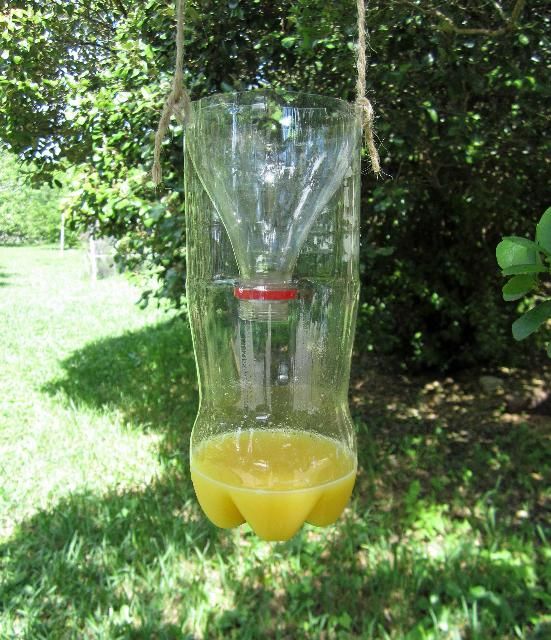
Credit: Adrian Hunsberger, University of Florida
Bed Bugs
Bed bugs are found around furniture where people sit or lie, such as beds, chairs, and sofas. Since professional treatment is expensive, confirming a bed bug infestation is valuable. A homemade CO2 trap takes advantage of these insects' attraction to carbon dioxide (CO2). A thermos flask containing dry ice (see Yellow Pages for suppliers) or a bottle containing a solution of yeast, sugar, and water releases a steady stream of CO2. For the latter, mix ¼ cup sugar and 1 gram brewer's yeast per cup of non-chlorinated or pre-boiled water. After a few hours, a steady stream of CO2 will be released through the funnel. Because CO2 is heavier than air, it concentrates at the base of the trap near the floor. Put the container on top of an inverted plastic pet dish or similar container. Cover the outer sides of the dish in fabric or masking tape to allow approaching bed bugs to climb inside but leave the inside surface clean so that the bugs cannot escape. A thin dusting of talcum powder placed inside the dish ensures trapped bed bugs cannot escape. Traps should be set at night individually near the bed or suspected infestation area. The CO2 sources are temporary and will need to be replaced for each subsequent monitoring period.

Credit: Robert Leckel, University of Florida
University of Florida scientists have also developed a simple trap that does not require a CO2 lure. The trap collects bed bugs as they travel between their human hosts and their hiding places. These traps use two different-sized smooth-sided containers (one inside the other) that are placed under the legs of beds and other furniture. Masking tape placed on the outermost and innermost sides of the large and small containers, respectively, will enable approaching bed bugs to enter either container—but not to exit back to the room. Car polish or a thin layer of talcum powder applied to the interior side of the larger and exterior side of the smaller container will ensure trapped bed bugs cannot escape.
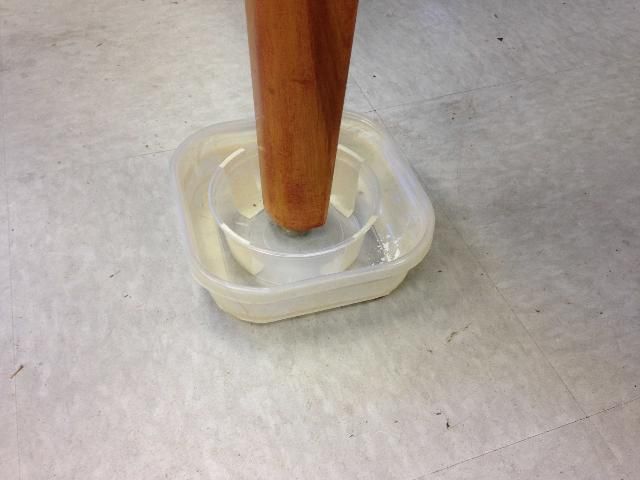
Credit: Benjamin A. Hottel, University of Florida
Cockroaches and Silverfish
Glue-boards or sticky cards, strategically placed in the corners of floors and shelves, under cabinets, or in other places where cockroaches and silverfish congregate, provide an alternative to using poisons and baits for these pests. A DIY sticky card for small cockroaches can be made from duct tape placed sticky side up on a piece of card or cardboard (4" by 6") and taped to the bottom or simply folded over at each edge and stuck to the floor. Baits, such as peanut butter, placed in the middle of the sticky card enhance these traps' attractiveness to cockroaches. Some commercial sticky traps also contain a pheromone that is claimed to attract cockroaches. A DIY poison-bait station for cockroaches can be made using powdered boric acid (or Borax) liberally mixed with slightly melted peanut butter. The bait can be applied in bottle caps or shallow container lids indoors or outdoors where infestations occur.
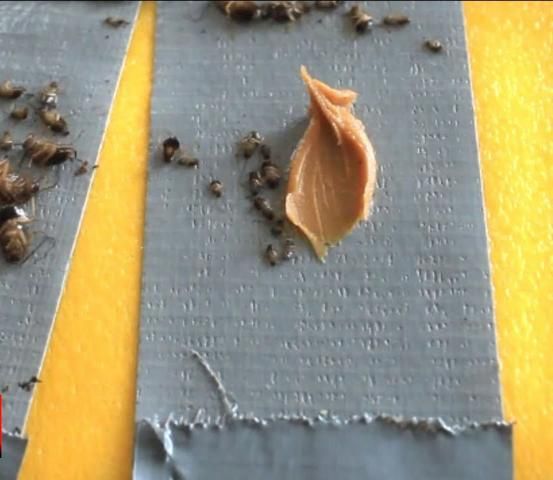
Credit: Ken Brown, KenuHawaii
Ants
A poison bait station for ants can be made by mixing boric acid, with sugar water or honey in a 2% concentration. The bait is placed in shallow container lids where ants are foraging. Any foraging ants should be allowed to carry food back to their nest, where the queen will eventually be killed. Not all species of ants are susceptible; in general, smaller species that are attracted to sugars will be most vulnerable. Place traps in a safe place away from access because boric acid is toxic and can cause serious illness to pets and children if ingested.

Credit: Stacy Makes Cents
Pantry Pests
Several moths and beetles, such as Indian meal moths and cigarette beetles, infest nuts and grain products including cereals, flour, and pasta in homes and other food storage locations. Sanitation, including cleaning up spills, and sealing stored foods in insect-proof containers will help prevent pantry pest problems. Where problems occur, a DIY pantry pest bait station may help. Mix cornmeal with boric acid (or Borax) and put it in jar lids to help eliminate a residual infestation of many stored product pests. Put the traps in the pantry and cupboards to attract remaining larvae. Additional boric acid or diatomaceous earth may be placed in cracks and corners of cabinets and cupboards to kill these pests, which can be removed later by vacuuming the residue.
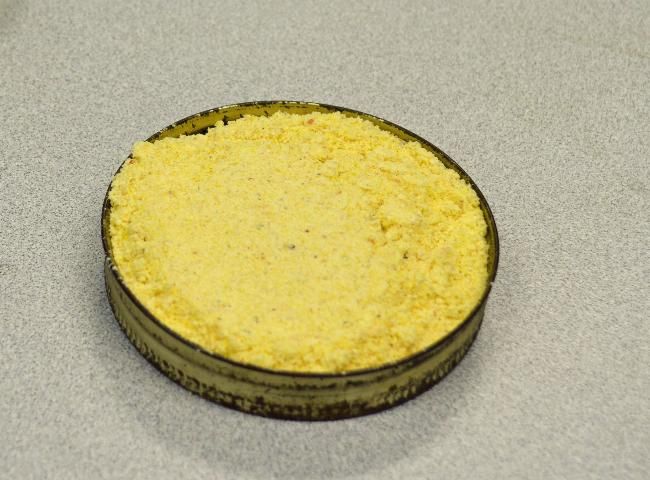
Credit: Robert Leckel, University of Florida
Commercial "pantry pest" traps employ a sex-pheromone that lures the adult stages of the insect (normally the male) to a sticky card that can be hung near a suspected infestation. Most traps contain a lure attractive to multiple pantry-pest species. The traps must be placed strategically because too many of them in a confined area may confuse moths and make the traps less effective. Similar pheromone traps are available for clothes moths.

Credit: Robert Leckel, University of Florida
Fleas
Fleas will gravitate towards sources of warmth and light. A DIY flea trap can be made with a light source (such as a bedside lamp) shining directly over a shallow, light-colored dish containing soapy water. An incandescent or heat-generating light bulb may work best. A tea light candle floated in the dish may also work and may be preferable because it eliminates the risk of mixing electricity and water. Adult fleas are highly mobile and are attracted to the traps while foraging at night. They quickly drown in the soapy water.
Stinkbugs
Some stinkbugs, such as the brown marmorated stinkbug (BMSB), enter homes or other structures in high numbers. The BMSB is attracted to light sources and can be caught at night with a light source directed at a reflective pan of water similar to the flea trap; although being a larger insect, the stinkbug may require deeper water than does the flea. A recent citizen science study concluded that an aluminum foil water pan trap was the most effective trap tested for collecting BMSB.
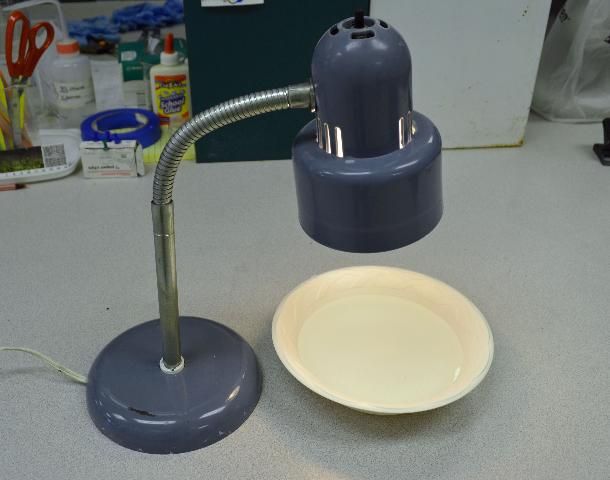
Credit: Robert Leckel, University of Florida
Biting/Stinging Pests
Mosquitoes and No-See-Ums
Mosquitoes and no-se-ums are highly attracted to CO2. Using this principle, the plastic bottle funnel trap described earlier can be baited with a sugar solution (non-chlorinated or pre-boiled water) and brewer's yeast (1 cup water, ¼ cup sugar and 1 gram yeast per 2-liter bottle). After a few hours, a steady stream of CO2 will be released through the funnel. Whenever the mixture stops bubbling, add fresh yeast and sugar to maintain the stream of CO2 and the effectiveness of the trap. Because mosquitoes are attracted to dark colors, adding black tape or painting the outside of the bottle black may increase its effectiveness. Traps can be used indoors or hung in places where the mosquitoes are biting.
Wasps
Social wasps including yellow jackets, hornets and paper wasps are common stinging insects that can be a nuisance when foraging near garbage cans or building nests (which they will defend) close to human activities. The plastic bottle funnel trap can be used as a simple DIY trap. Adding petroleum jelly or cooking oil along the inside edges of the funnel can cause wasps to slip inside the trap. Preferred baits vary according to the season and wasp species. In general protein baits (e.g., hamburger) work best in the spring when wasps are building their colonies while carbohydrate baits (e.g., fermenting fruits or beer) may be more effective in the late summer and fall. Do not use honey because it may attract honeybees. Hang traps about 4 to 5 feet above the ground. For safety, place them away from sites of human activity.
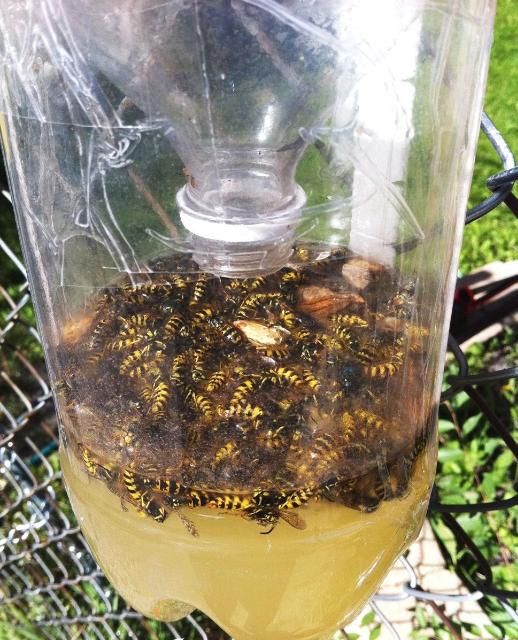
Credit: Alison Zulyniak
Deer Flies, Yellow Flies, and Horse Flies
Flies in the family Tabanidae include aggressive biting pests of cattle, horses, and humans. They are active during daylight hours and most frequently encountered in summer and early fall near shaded and swampy areas, where they breed. Commercial traps such as the Horse Pal® have been developed based on the attraction of these flies to dark moving objects. Such traps may be employed in small areas, such as yards, camping sites, swimming pools, or confined livestock yards. The "trolling deer fly trap" is an inexpensive DIY trap developed at the University of Florida. The trap consists of an inverted 6-inch plastic nursery pot painted bright blue and covered with sticky viscous material such as Tanglefoot™ available at garden outlets. Because flies are attracted to movement, placing traps on slow-moving vehicles, such as lawn mowers, greatly increases their effectiveness. A black ball hung from lower branches of trees in a windy spot (to induce swinging movement) and covered in a viscous adhesive may also attract and kill tabanid flies.
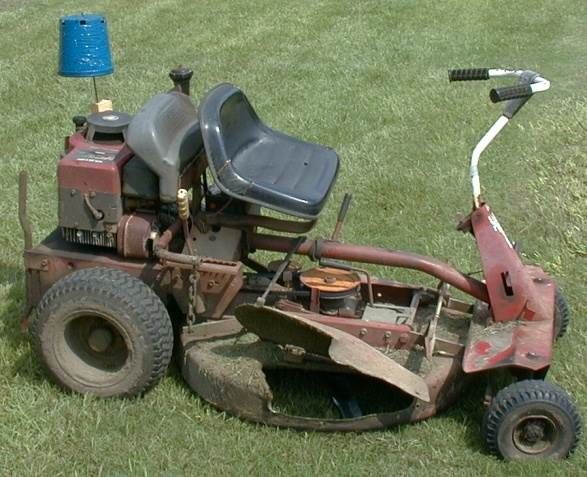
Credit: Russ Mizell, University of Florida
Garden Pests
Many insects attack flowers, fruits, vegetables, and turf. Populations of these garden pests may not be readily detected until they reach damaging levels, due to the insects' small size, cryptic habits, or nocturnal habits. Fortunately, several traps and monitoring devices can help alert gardeners to their presence, allowing appropriate control measures to be taken if needed.
Aphids, Thrips, Whiteflies, Leafminers
Yellow, blue, or white sticky traps are the simplest and most inexpensive tool for monitoring aphids, thrips, whiteflies, leafminers, and many other small flying insects that infest flower or vegetable gardens. Insect sticky traps are available through many garden outlets, although homemade versions can be made from plastic plates or cups thinly covered with petroleum jelly, Vaseline, or non-toxic sticky insect barrier available in garden stores. Traps can be attached to bamboo canes and placed at windward edges near the plant canopy and inspected frequently during the growing season. Traps should be replaced once the sticky material becomes contaminated. In greenhouses, sticky traps should be placed near doors, vents, or other areas where pests may first gain entry.
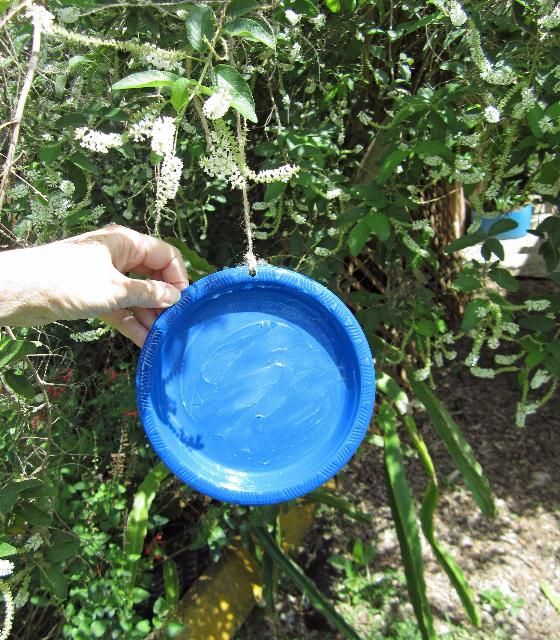
Credit: Adrian Hunsberger, University of Florida
Sticky plant barrier traps may also be used where ants are found "herding" aphids, soft scales, or other honeydew secreting insects. Ants tending these plant-feeding insects protect them from natural enemies, resulting in dramatically increased pest infestations. In cases where ants are observed interacting with aphids and feeding on their honeydew, a sticky barrier of petroleum jelly placed around the bases or stems of infested plants will trap and deter ants and thus allow natural control methods to become reestablished.
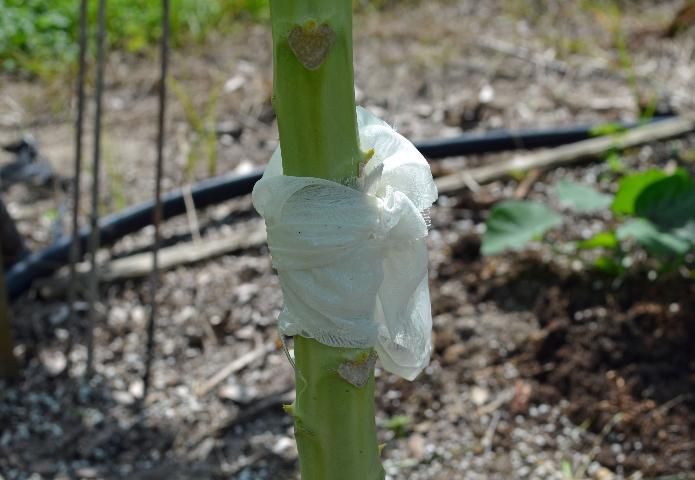
Credit: Robert Leckel, University of Florida
Fruit Flies
Disposable cups baited with apple cider vinegar are highly attractive fruit fly traps in homes, gardens, and orchards. Poke small holes in the cup to allow flies inside. Fruit flies that enter the trap quickly drown in the vinegar. Hang cups wherever fruit fly infestations occur or as a pest-monitoring tool in orchards.
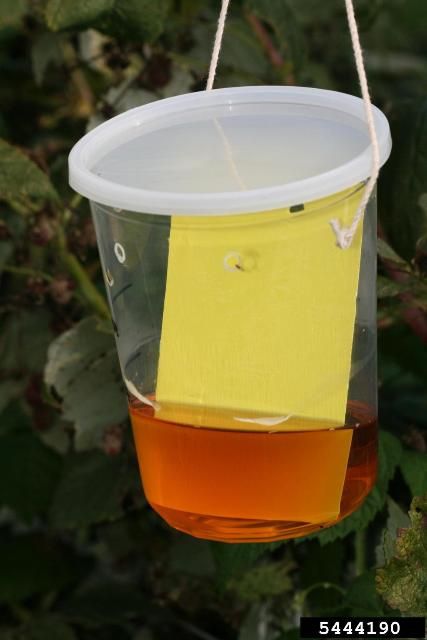
Credit: Hannah Burrack, North Carolina State University, Bugwood.org
Slugs and Snails
Pitfall traps can be used to protect seedlings, vegetables, and other susceptible garden plants from slugs and snails. The presence of slime trails in the ground may indicate the need for traps and the best location to place traps. An empty jar or plastic container buried in the soil and half-filled with beer (or baking yeast and sugar solution) attracts and drowns the mollusks as they forage nocturnally. Place a pitfall trap with the top slightly elevated from the ground surface to reduce the risk of collecting ground beetles, spiders, or other beneficial predators. A raised cover over the trap will reduce evaporation or dilution from rainfall or irrigation. Some commercial versions of these pitfall traps have an inner container with a small hole that can be used to remove trap contents without needing to refill.

Credit: Andrew Stansfields
An old wooden board or pallet slightly raised from the ground serves as a daytime resting place for slugs and snails and other pests such as earwigs. Check board traps during the day and eliminate pests by knocking them into a jar of soapy water. Board traps may also harbor ground beetles and other beneficial insects that eat mollusks, and these should therefore not be removed.
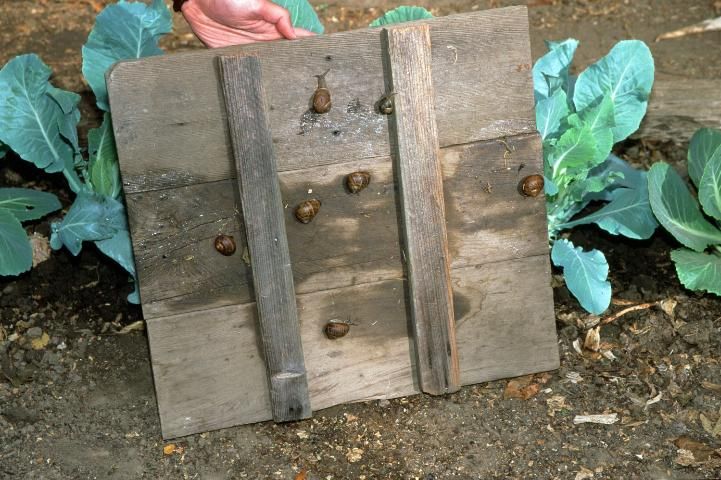
Credit: Jack Kelly Clark, used with permission from University of California Statewide IPM Program (www.ipm.ucdavis.edu)
Cutworms
The larvae of some noctuid moths chew through the stems of young plants, killing them. These "cutworms" typically hide in the ground during the day and are easy to overlook. Vulnerable seedlings can be protected with a section of cardboard tube placed around the stem and pushed a few inches into the ground. These "cutworm collars" can be made from used toilet paper rolls, which will naturally decompose after a few weeks, when the plants will be less susceptible to damage.
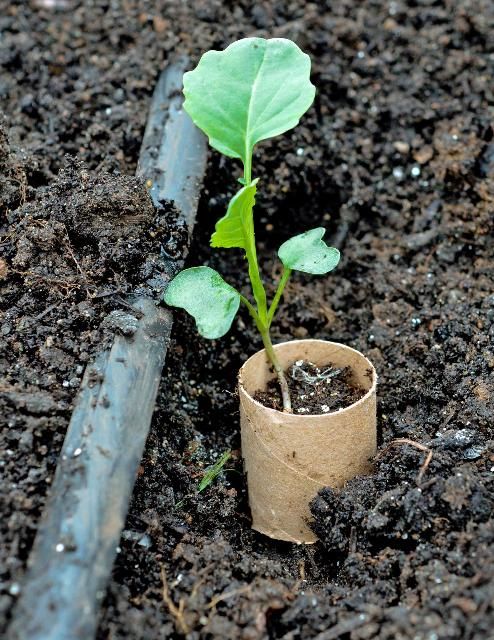
Credit: Hilary Dahl, Seattle Urban Farm Company
Landscape Pests
Pests of ornamental trees and shrubs may become problematic for homeowners, as well as growers and landscapers charged with their care. The location and abundance of some of these pests can be monitored with simple DIY traps. The strategic use of traps for landscape pests may help manage pests or assist in performing further control operations should they be needed, such as the application of insecticides.
Tree-Feeding Caterpillars
Tent-making and other gregarious caterpillars can defoliate trees causing aesthetic, although rarely permanent, damage. Many of these caterpillars migrate up and down the trunk to hide from predators during the day, especially when they are large and most mobile. Burlap or cloth tree band traps tied around the trunk at chest height effectively trap these caterpillars as they seek hiding places. The fabric can be folded over to create a "skirt," which provides additional hiding spaces. The bands can be replaced or reused after caterpillars are removed and placed in a bucket of soapy water to kill them. Wear gloves when handling caterpillars because some of them have irritating or urticating hairs or bristles.
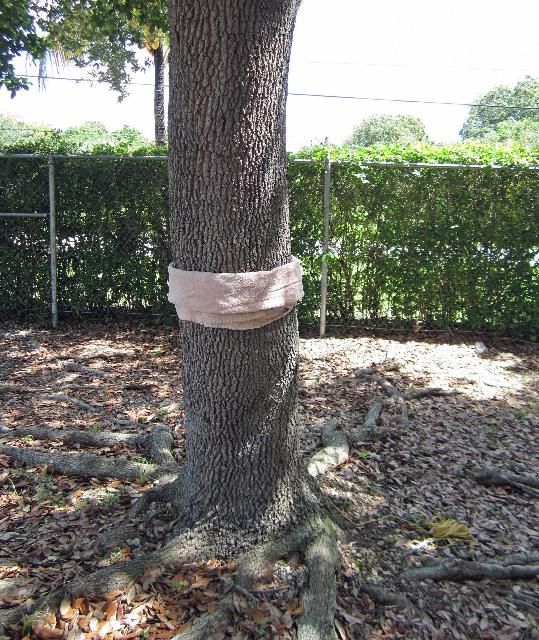
Credit: Adrian Hunsberger, University of Florida
Scale Insects and Mealybugs
Insects of the superfamily Coccoidea are a diverse group of small to medium-sized insects that infest many woody ornamental plants found in the landscape. Scales are often overlooked as insects since they grow beneath wax covers (scales) or are covered with mealy wax (mealybugs). The primary mobile stage is the first crawler stage, which is also the most susceptible to insecticides. Double-sided sticky tape (available in stationery stores) can be used as a simple monitoring device to determine crawler activity. To make tape traps, the tape is wrapped around twigs or small branches and doubled over to make a handle to unwind. Crawlers get stuck on the tape as they migrate to new spring growth in search of feeding sites, appearing as yellow or orange specks. Examine the traps with a hand lens to identify crawlers. Placing 2 or 3 traps per tree in locations in the early spring will help determine the need and timing for contact insecticides, such as horticultural oils. A variation is the sail trap, which can be used to catch the gnat-like adult male scales and parasitoids of the scale.
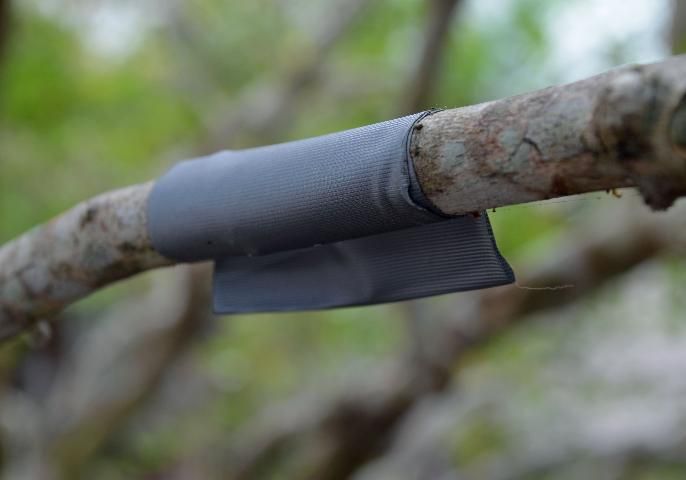
Credit: Robert Leckel, University of Florida
Tree Boring Beetles
Bark and ambrosia beetles are important pests of trees in forests, nurseries, and urban landscapes. Small-diameter trees that are stressed are most susceptible to attack. Symptoms include wilted foliage and strands of boring dust protruding from small, round holes. Ambrosia beetles can be easily monitored with ethanol traps made from plastic cups or inverted soda bottles containing soapy water and baited with ethyl alcohol (ethanol) released via a cotton wick. Alternatively liquid hand sanitizer containing at least 65% ethanol can be dispensed directly into the bottom of the trap. Traps should have a strategically cut window in the side to allow entrance of flying beetles, which drown in the soapy water or liquid hand sanitizer. Traps should be hung from a branch or attached to a stake in the afternoon when temperatures are above 70°F and checked the next day. A citizen science bark beetle project shows how to make ethanol traps and get bark beetles identified.
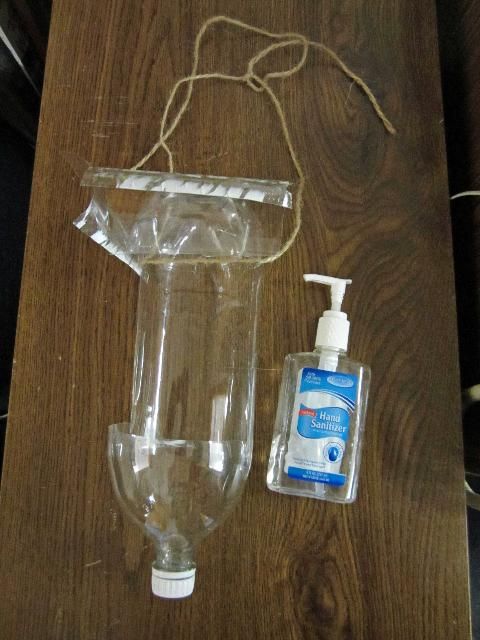
Credit: Adrian Hunsberger, University of Florida
Street Tree Aphids
Aphids sometimes build up large numbers on tall trees in the landscape. The resulting dripping honeydew and associated sooty molds can foul pavements and parked cars below. If insecticides are to be used, water-sensitive paper can be used as a simple indirect monitoring device to determine the activity of these aphids (via dripping honeydew) and help time applications. The water-sensitive paper should be suspended horizontally below main branches of the tree where aphids are active. A threshold of 1 to 2 drops per cm/4 hours has been recommended as a threshold for trunk injections.
Palm and Banana Weevils
The giant palm weevil or palmetto weevil (Rhynchoporus cruentatus) attacks palms, including the sabal, coconut, and date palms, in Florida and elsewhere. The silky cane weevil (Metamasius hemipterus sericeus) attacks banana, Musa spp., palms, and sugarcane. Stressed, damaged, and recently transplanted trees or plants are the most susceptible. These pests are very destructive since an infestation is rarely found at the early stage and severely infested trees are difficult to treat. Black 5-gallon bucket traps baited with palm stem tissue, sugarcane (cut into 2- to 4-inch pieces), or pineapple are used to attract weevils. Baffles constructed from 5 cm long PVC glued together longitudinally and placed over bucket openings effectively prevent weevils from escaping. Small draining holes should be added to the buckets. Traps should be secured with rebar or stakes. Hardware cloth (heavy wire screening) can be used to protect the bait from animals (especially raccoons). Traps should be situated away from susceptible trees. Traps can be synergized by using the synthesized and commercially available male-produced aggregation pheromones of these weevils (http://www.chemtica.com/site/?p=1766; http://www.chemtica.com/site/?p=2953) as well as the wounded plant kairomone, ethyl acetate (http://www.chemtica.com/site/?p=1774).
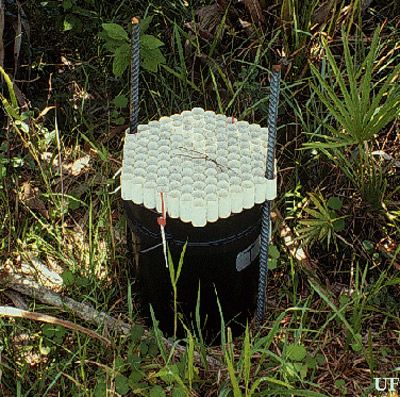
Credit: Robin M. Giblin-Davis, University of Florida
May/June Beetles
The larvae of beetles in the family Scarabaeidae (scarabs) are pests of turf and ornamental plants. Root feeding by the larvae can cause significant decline in lawns while the adult stage of some species feeds on trees and shrubs. Day-flying scarabs like the green June beetle, flower beetles, and Japanese beetles can be caught in a DIY food-bait scarab trap. The trap consists of a one-gallon milk jug or similar container, with large windows cut in the side. The lid or cap should not be removed. The trap is baited with fermenting foods, such as beer and an over-ripe banana placed inside a smaller container. Beetles attracted to the baits enter the trap, where they drown in soapy water. The traps should be hung from tree branches or fence posts and checked weekly, with the bait refreshed at least monthly. Night-active May/June beetles are attracted to light-colored objects. A white bucket scarab trap containing soapy water can be placed under trees or shrubs where feeding damage is observed. Commercial pheromone traps are available for the adult stages of some scarabs.

Credit: Robert Leckel, Adrian Hunsberger, University of Florida
Japanese Beetle
The Japanese beetle is a common pest throughout much of the eastern United States (excluding Florida). In addition to turf damage, the adult stage feeds on many landscape plants. Commercial traps which intercept flying beetles into a disposable bag or container are widely available in garden stores. A funnel placed in a hole in the lid of a bucket is a homemade variation of this trap, although the specific dual activity lure needs to be purchased separately. Since research suggests that Japanese beetle traps may attract more beetles than are caught, these traps should be placed away from susceptible plants.
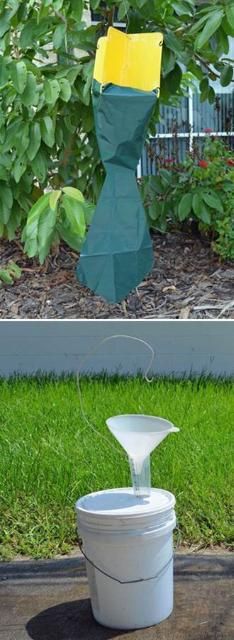
Credit: Robert Leckel, University of Florida
Chinch Bugs
The southern chinch bug is a damaging pest of St. Augustinegrass and other warm-season grasses in Florida and elsewhere. Since they are small and hard to see, they may be trapped using the floatation method. The trap consists of an empty metal food can with the bottom removed. To test for chinch bug presence, the can is inserted into the soil on the perimeter of damaged turf, where active feeding is anticipated. A knife may be used to cut a groove in the soil for the can. Adding water for several minutes will cause any chinch bugs to float to the surface where they can be easily observed and counted. This method should be repeated in several locations to ensure proper diagnosis.
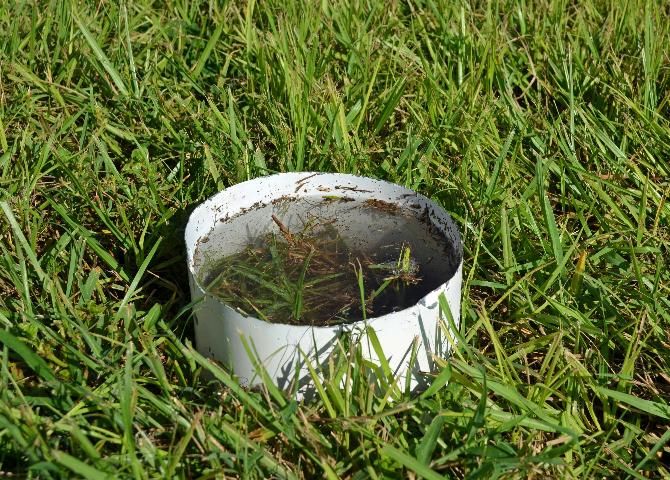
Credit: Robert Leckel, University of Florida
Night-Flying Insects
Light-trapping is a general term for attracting and capturing nocturnal insects with lamps, especially those that emit light in the ultraviolet range, e.g., mercury vapor lamps, black light lamps, or fluorescent tubes. A simple light trap can be made from a funnel, a round bucket, and a light. The funnel is placed in the container and the light source suspended above. Insects attracted to the light fall through the funnel and are trapped. Newspaper strips, egg boxes, or similar materials provide a hiding place for trapped insects. Hanging a black light adjacent to a vertically suspended white sheet outdoors is an excellent way to observe large numbers of nocturnal insects, including moths and beetles. In addition to the need for a power source, the main disadvantage of light traps is their rather indiscriminate nature. They catch many different types of insects without necessarily controlling any specific one.
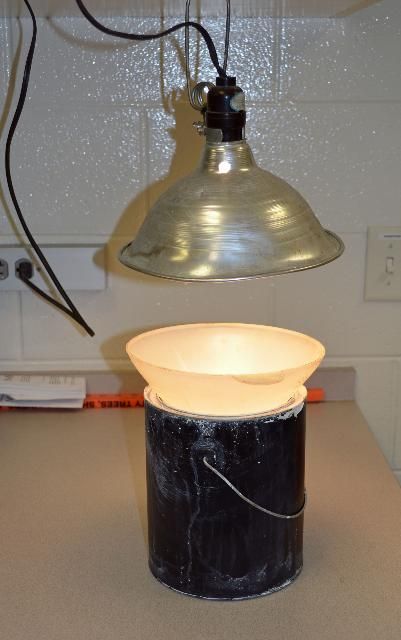
Credit: Robert Leckel, University of Florida
Conclusions
Many different insect traps can be made using household materials. These traps may be as effective as those obtained through garden retail outlets, Do-It-Yourself pest control outlets, or internet stores. Many cooperative Extension articles, gardening blogs, and YouTube videos are a valuable resource to show how insect traps can be made and used. We caution that while traps can be useful to determine the presence of many pests, traps by themselves may be insufficient to manage persistent pest infestations. In such cases, supplemental control methods and consultation with an Extension specialist or professional pest control company is recommended.
Further Reading
Aigner, J. D., and T. P. Kuhar. 2014. "Using citizen scientists to evaluate light traps for catching brown marmorated stink bugs in homes in Virginia." Journal of Extension 52(4): Article # 4RIB5
Dreistadt, S. H., and M. L. Flint. 1995. "Landscape pest monitoring methods and training managers to use them." Journal of Arboriculture 21(1): 1–6.
Epsky, N. D., W. L. Morrill, and R. W. Mankin. 2008. "Traps for Capturing Insects." Encyclopedia of Entomology (Ed. Capinera JL.), Springer, pp 3887–3901.
Hottel, B. A., R. W. Baldwin, R. M. Pereira, and P. G. Koehler. 2014. How to make a bed bug interceptor trap out of common household items. ENY-2029. Gainesville: University of Florida Institute of Food and Agricultural Sciences. https://edis.ifas.ufl.edu/publication/in1022 (8 June 2022)
Hulcr, J., and N. McCoy. 2013. Catching Beetles. How do I trap ambrosia and bark beetles? Use the Bambara Beetle Trap! Ambrosia Symbiosis. http://www.ambrosiasymbiosis.org/ambrosia-beetles/catching-beetles/ (accessed 24 Sept. 2018)
Klostermeyer, L. E. 1985. "Japanese beetle (Coleoptera: Scarabaeidae) traps: Comparison of commercial and homemade traps." Journal of Economic Entomology, 78(2): 454–459.
Lindgren, B. S. 1983. "A multiple funnel trap for scolytid beetles (Coleoptera)." The Canadian Entomologist, 115, 299–302.
Mizell, R. F. III, R. F. Mizell, and R. A. Mizell. 2002. "Trolling: A novel trapping method for Chrysops spp. (Diptera: Tabanidae)." Florida Entomologist, 85(2): 356–366.
Ogg, B. n.d. Do-It-Yourself Bed Bug Trap. University of Nebraska Lincoln Extension publication 338. (No longer available online.)
Squitter, J. M. 1998 (revised 2014). Deer flies, yellow flies and horse flies: Chrysops, Diachlorus, and Tabanus spp. (Insecta: Diptera: Tabanidae). EENY-028. Gainesville: University of Florida Institute of Food and Agricultural Sciences. https://entnemdept.ufl.edu/creatures/livestock/deer_fly.htm (accessed September 2018).
Steiner, A., and C. L. Haeuser. 2010. "Recording insects by light-traps." Abc Taxa 8(2): 400–422.
Steininger, M. S., J. Hulcr, M. Šigut, and A. Lucky. 2015. "Simple and efficient trap for bark and ambrosia beetles (Coleoptera: Curculionidae) to facilitate invasive species monitoring and citizen involvement." Journal of Economic Entomology, https://academic.oup.com/jee/article/108/3/1115/2379616
University of Wisconsin—Extension. Gypsy Moth in Wisconsin: Making a burlap barrier band trap. https://fyi.extension.wisc.edu/spongymothinwisconsin/pest-management-2/making-a-burlap-barrier-band-trap/ (8 June 2022)
Weissling, T. J., R. M. Giblin-Davis, R. H. Scheffrahn, and N. M. Mendoza. 1992. "Trap for capturing and retaining Rhynchophorus cruentatus (Coleoptera: Curculionidae) adults using Sabal palmetto as bait." Florida Entomologist, 212–221. https://www.jstor.org/stable/3495623 (25 August 2015)